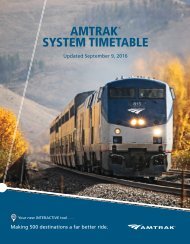Queens
northeast_queens_bus_study_-_final_9-28-15
northeast_queens_bus_study_-_final_9-28-15
You also want an ePaper? Increase the reach of your titles
YUMPU automatically turns print PDFs into web optimized ePapers that Google loves.
, Metropolitan Transportation Authority<br />
Trip Length (NYC Transit Authority Routes Only)<br />
Bus trips on Northeast <strong>Queens</strong> routes exhibit slightly longer trips than those in the rest of <strong>Queens</strong>.<br />
Weekday trips are 9.9% longer than trips made in other parts of <strong>Queens</strong>. The two sets of <strong>Queens</strong> routes<br />
were compared with a t‐test, and the average trip lengths are meaningfully different to a confidence<br />
interval greater than 90%.<br />
Table 17. Weekday Average Trip Comparisons<br />
Weekday Average Trip Length<br />
Set Of Routes<br />
(Miles)<br />
<strong>Queens</strong> Routes 2.81<br />
Northeast <strong>Queens</strong> Routes 2.90<br />
Non‐NE <strong>Queens</strong> Routes 2.64<br />
Within the set of Northeast <strong>Queens</strong> NYCT bus routes there is a considerable amount of variance in the<br />
average trip length. The longest average trips are seen on the Q27 Limited, where trips are almost 5 miles<br />
long. The average trip length for Q1 customers is 4.1 miles and 3.71 miles for Q46 Limited customers, the<br />
second and third longest trips among bus routes in the study area. The Q20B and Q26 customers have the<br />
shortest average trip lengths on weekdays at 1.55 miles and 1.79 miles, respectively. These two routes<br />
are the only bus routes in Northeast <strong>Queens</strong> that have average trips less than two miles. The full table of<br />
weekday average trip length for Northeast <strong>Queens</strong> NYCT bus routes is located in Appendix C: Additional<br />
Data of this report.<br />
Transfers<br />
Bus‐to‐Subway Transfers by Route<br />
Of the 29 local bus routes in Northeast <strong>Queens</strong>, nine are specifically designated as subway “feeder” routes,<br />
where more than half of customers on these routes are primarily interested in getting to a subway for the<br />
remainder of their journey. The remaining routes, called “grid” routes, see fluctuating ridership along the<br />
route with customers boarding and alighting throughout the entire length of the route, but also serve<br />
subway stations as well. It is unsurprising that a significant number of bus trips are followed by a swipe<br />
into a subway station. On an average weekday in May, 58,300 bus customers transferred from Northeast<br />
<strong>Queens</strong> routes to a subway. Assuming that customers make round trips doubles this number, over a third<br />
(39.0%) of bus trips are also associated with a subway journey. The following table presents routes in<br />
Northeast <strong>Queens</strong> by the amount of passengers they deliver to subway stations for an additional journey.<br />
It also compares the number of transfers to total ridership. It is evident from this fraction that for some<br />
routes within Northeast <strong>Queens</strong> the most important function is feeding to the subway. For determining<br />
the number of bus trips that are associated with a subway trip, it was assumed that every bus‐to‐subway<br />
transfer generates a symmetrical subway‐to‐bus transfer as well.<br />
Table 18. Bus‐to‐Subway Weekday Transfers by Bus Route (May 2014)<br />
Route<br />
Bus‐To‐Subway<br />
Transfers Weekday Ridership<br />
Portion of Trips<br />
Subway Transfer<br />
Q26 586 1,492 79%<br />
Q64 3,982 10,943 73%<br />
Q16 1,221 4,144 59%<br />
Q46 5,963 23,507 51%<br />
Q36 1,505 6,376 47%<br />
34



